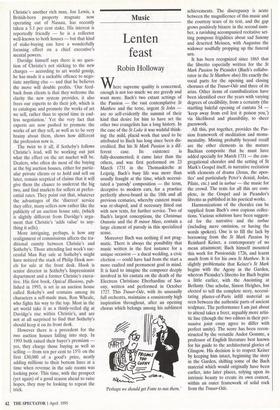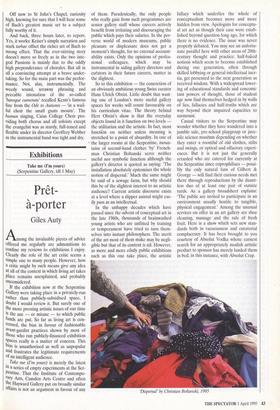M u s ic
Lenten feast
Robin Holloway
Where supreme quality is concerned, enough is not too much: we are greedy and want more. Bach's two extant settings of the Passion — the vast contemplative St Matthew and the terse, urgent St John are so self-evidently the summit of their kind that desire for him to have set the other two evangelists has a long history. In the case of the St Luke it was wishful think- ing: the mild, placid work that used to be attributed to Bach has long since been dis- credited. But his St Mark Passion is a dif- ferent case. Its existence is fully-documented; it came later than the others, and was first performed on 23 March 1731 in the Thomaskirche at Leipzig. Bach's busy life was more than usually fraught at the time, which necessi- tated a 'parody' composition — the term, deceptive to modern ears, for a practice perfectly above-board in the 18th and all previous centuries, whereby existent music was re-shaped, and if necessary fitted out with new texts, for further service. Two of Bach's largest conceptions, the Christmas Oratorio and the B minor Mass, contain a large element of parody in this specialized sense.
Moreover Bach was nothing if not prag- matic. There is always the possibility that music written in the first instance for a unique occasion — a ducal wedding, a civic election — could have had from the start a more exalted and permanent goal in mind. It is hard to imagine the composer deeply involved in his cantata on the death of the Electress Christiane Eberhardine of Sax- ony, written and performed in October 1727. This Trauer-Ode, with its unusually full orchestra, maintains a consistently high inspiration throughout, after an opening chorus which belongs among his sublimest `Perhaps we should get Forte to run them.' achievements. The discrepancy is acute between the magnificence of this music and the courtesy tears of its text, and the gap grows positively bizarre in the second num- ber, a ravishing accompanied recitative set- ting pompous frigidities about sad Saxony and deserted Meissen, with Augustus the widower soulfully propping up the funeral urn.
It has been recognized since 1865 that the libretto especially written for the St Mark Passion by Picander (Bach's collabo- rator in the St Matthew also) fits exactly the vocal parts for the opening and closing choruses of the Trauer-Ode and three of its arias. Other items of cannibalization have been identified over the years with varying degrees of credibility, from a certainty (the startling baleful opening of cantata 54 'keep away from evil lest it poison you,') via likelihood and plausibility, to sheer guesswork.
All this, put together, provides the Pas- sion framework of meditation and monu- mentality. Missing probably beyond recall are the other elements in the mature Bachian composite that he must have added specially for March 1731 — the con- gregational chorales and the setting of St Mark's Gospel itself, in narrative recitation with elements of drama (Jesus, the apos- tles' and particularly Peter's denial, Judas, Pilate, etc.) and in turbae — the music for the crowd. The texts for all this are com- plete, in the Gospel and in Picander's libretto as published in his poetical works.
Harmonizations of the chorales can be supplied from Bach's own copious collec- tions. Various solutions have been suggest- ed for the narrative and the turbae (including mere omission, or having the words spoken). One is to fill the lack by borrowing from the St Mark Passion by Reinhard Keiser, a contemporary of no mean attainment; Bach himself mounted this work for Passiontide 1726, and learnt much from it for his own St Matthew. It is slightly problematic that Keiser's St Mark begins with the Agony in the Garden, whereas Picander's libretto for Bach begins a little earlier, with the Anointing at Bethany. One scholar, Simon Heighes, has elected to tell the complete story, necessi- tating plaster-of-Paris infill material as seen between the authentic parts of ancient sculpture. The performance I am just about to attend takes a freer, arguably more artis- tic line (though the two editors in their per- suasive joint essay agree to differ with perfect amity). The score has been recon- structed by the versatile Andor Gomme, a professor of English literature best known for his guide to the architectural glories of Glasgow. His decision is to respect Keiser by keeping him intact, beginning the story in the Garden, shifting some of the Bach material which would originally have been earlier, into later places, relying upon its intrinsic beauty to create its own context, within an outer framework of solid rock from the Trauer-Ode. Off now to St John's Chapel, curiosity high, knowing for sure that I will hear some of Bach's greatest music set to a subject fully worthy of it.
And back, three hours later, to report. Yes, it works: Keiser's simple narration and stark turbae offset the richer art of Bach to strong effect. That the ever-stirring story doesn't move so freely as in the two inte- gral Passions is mainly due to the oddly high preponderance of chorales. But all in all a convincing attempt at a brave under- taking. So for the main part was the perfor- mance. Not, alas, instrumentally. The weedy sound, scrawny phrasing and peccable intonation of the so-called `baroque camerata' recalled Keats's famous line from the Ode to Autumn — `in a wail- ful choir the small gnats mourn'. The human singing, Caius College Choir pro- viding both chorus and all soloists except the evangelist was as sturdy, full-toned and flexible under its director Geoffrey Webber as the instrumental band was tight and dry.



























































 Previous page
Previous page